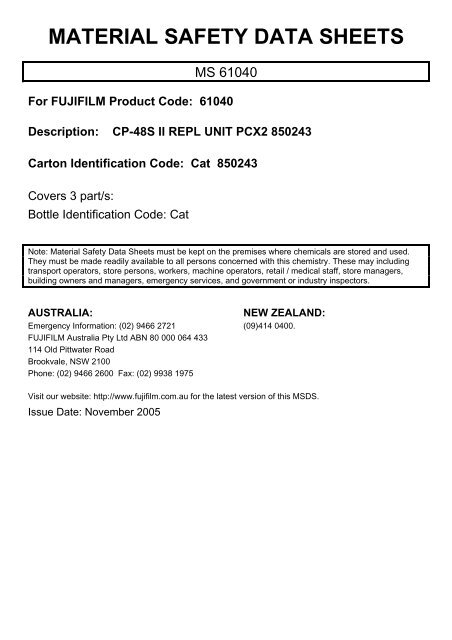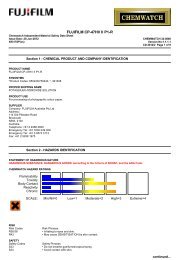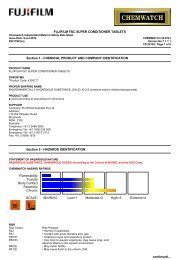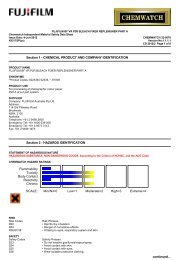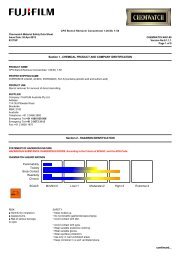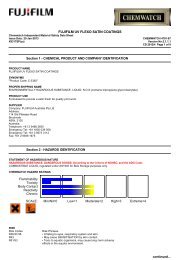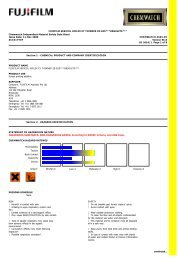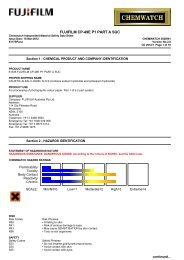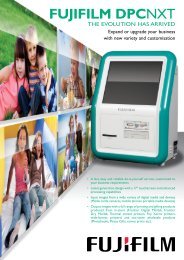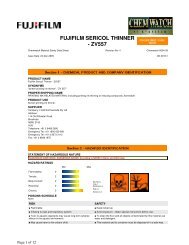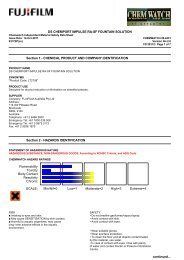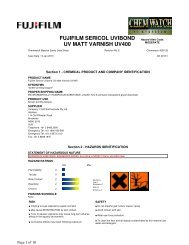CP48S II PC P2R PART A - FUJIFILM Australia
CP48S II PC P2R PART A - FUJIFILM Australia
CP48S II PC P2R PART A - FUJIFILM Australia
You also want an ePaper? Increase the reach of your titles
YUMPU automatically turns print PDFs into web optimized ePapers that Google loves.
MATERIAL SAFETY DATA SHEETSMS 61040For <strong>FUJIFILM</strong> Product Code: 61040Description: CP-48S <strong>II</strong> REPL UNIT <strong>PC</strong>X2 850243Carton Identification Code: Cat 850243Covers 3 part/s:Bottle Identification Code: CatNote: Material Safety Data Sheets must be kept on the premises where chemicals are stored and used.They must be made readily available to all persons concerned with this chemistry. These may includingtransport operators, store persons, workers, machine operators, retail / medical staff, store managers,building owners and managers, emergency services, and government or industry inspectors.AUSTRALIA:NEW ZEALAND:Emergency Information: (02) 9466 2721 (09)414 0400.<strong>FUJIFILM</strong> <strong>Australia</strong> Pty Ltd ABN 80 000 064 433114 Old Pittwater RoadBrookvale, NSW 2100Phone: (02) 9466 2600 Fax: (02) 9938 1975Visit our website: http://www.fujifilm.com.au for the latest version of this MSDS.Issue Date: November 2005
Product Name: <strong>CP48S</strong> <strong>II</strong> <strong>PC</strong> <strong>P2R</strong> <strong>PART</strong> AThis revision issued: November, 2005Emergency Information: 02 9466 2721 (Aust), (09)414 0400 (NZ)Page: 1 of 5SECTION 1 - IDENTIFICATION OF CHEMICAL PRODUCT AND COMPANY<strong>FUJIFILM</strong> <strong>Australia</strong> Pty Ltd ABN 80 000 064 433<strong>FUJIFILM</strong> (NZ) Limited114 Old Pittwater Rd Cnr William Pickering Dr & Bush RdBrookvale NSW 2100Albany, AucklandPhone: 02 9466 2600 Fax: 02 9938 1975 Phone (09)414 0400Emergency Information: (02)9466 2721 (Aust), (09)414 0400 (NZ)http://www.fujifilm.com.au/Substance:Water solution of ingredients.Trade Name:<strong>CP48S</strong> <strong>II</strong> <strong>PC</strong> <strong>P2R</strong> <strong>PART</strong> AProduct Code: 850243 750244Product Use:Photographic reagent. This is Part A of a two part system.Creation Date: November, 2005Revision Date: November, 2005SECTION 2 - HAZARDS IDENTIFICATIONStatement of Hazardous NatureThis product is classified as: Hazardous according to the criteria of NOHSC <strong>Australia</strong>.Not a Dangerous Good according to the <strong>Australia</strong>n Dangerous Goods (ADG) Code.Risk Phrases: R36/38. Irritating to eyes and skin.Safety Phrases: S26, S24/25, S37/39. In case of contact with eyes, rinse immediately with plenty of water andcontact a doctor or Poisons Information Centre. Avoid contact with skin and eyes. Wear suitable gloves and eye/faceprotection.SUSDP Classification: None allocated.ADG Classification: None allocated. Not a Dangerous Good under the ADG Code.UN Number: None allocatedPhysical Description & colour: Dark brown liquid.Odour: No odour.Major Health Hazards: irritating to eyes and skin.Emergency OverviewPotential Health EffectsInhalationShort term exposure: Available data indicates that this product is not harmful. In addition product is unlikely tocause any discomfort or irritation.Long Term exposure: No data for health effects associated with long term inhalation.Skin Contact:Short term exposure: Available data indicates that this product is not harmful. It should present no hazards innormal use. However product is a skin irritant. Symptoms may include itchiness and reddening of contacted skin.Other symptoms may also become evident, but all should disappear once exposure has ceased.Long Term exposure: No data for health effects associated with long term skin exposure.Eye Contact:Short term exposure: This product is an eye irritant. Symptoms may include stinging and reddening of eyes andwatering which may become copious. Other symptoms may also become evident. If exposure is brief, symptomsshould disappear once exposure has ceased. However, lengthy exposure or delayed treatment may cause permanentdamage.Long Term exposure: No data for health effects associated with long term eye exposure.Ingestion:Short term exposure: Significant oral exposure is considered to be unlikely. This product is unlikely to cause anyirritation problems in the short or long term.Long Term exposure: No data for health effects associated with long term ingestion.
Product Name: <strong>CP48S</strong> <strong>II</strong> <strong>PC</strong> <strong>P2R</strong> <strong>PART</strong> AThis revision issued: November, 2005Emergency Information: 02 9466 2721 (Aust), (09)414 0400 (NZ)Page: 2 of 5Carcinogen Status:NOHSC: No significant ingredient is classified as carcinogenic by NOHSC.NTP: No significant ingredient is classified as carcinogenic by NTP.IARC: No significant ingredient is classified as carcinogenic by IARC.SECTION 3 - COMPOSITION/INFORMATION ON INGREDIENTSIngredients CAS No Conc,% TWA (mg/m 3 ) STEL (mg/m 3 )Benzoic Acid Derivative 1-5 not set not setsuccinic acid 110-15-6 1-5 not set not setAmmonium nitrate 6484-52-2 3-7 not set not setEDTA 21265-50-9 7-15 not set not setWater 7732-18-5 to 100 not set not setThis is a commercial product whose exact ratio of components may vary slightly. Minor quantities of other nonhazardous ingredients are also possible.The TWA exposure value is the average airborne concentration of a particular substance when calculated over a normal 8 hour working day for a 5day working week. The STEL (Short Term Exposure Limit) is an exposure value that should not be exceeded for more than 15 minutes and shouldnot be repeated for more than 4 times per day. There should be at least 60 minutes between successive exposures at the STEL. The term "peak "isused when the TWA limit, because of the rapid action of the substance, should never be exceeded, even briefly.SECTION 4 - FIRST AID MEASURESGeneral Information:You should call The Poisons Information Centre if you feel that you may have been poisoned, burned or irritated bythis product. The number is 13 1126 from anywhere in <strong>Australia</strong> (0800 764 766 in New Zealand) and is available at alltimes. Have this MSDS with you when you call.Inhalation: First aid is not generally required. If in doubt, contact a Poisons Information Centre or a doctor.Skin Contact: Wash gently and thoroughly with warm water (use non-abrasive soap if necessary) for 10-20 minutesor until product is removed. Under running water, remove contaminated clothing, shoes and leather goods (e.g.watchbands and belts) and completely decontaminate them before reuse or discard. If irritation persists, repeatflushing and seek medical attention.Eye Contact: Immediately flush the contaminated eye(s) with lukewarm, gently flowing water for 20 minutes or untilthe product is removed, while holding the eyelid(s) open. Take care not to rinse contaminated water into theunaffected eye or onto the face. Obtain medical attention immediately. Take special care if exposed person is wearingcontact lenses.Ingestion: If product is swallowed or gets in mouth, wash mouth with water and give some water to drink. Ifsymptoms develop, or if in doubt contact a Poisons Information Centre or a doctor.SECTION 5 - FIRE FIGHTING MEASURESFire and Explosion Hazards: There is no risk of an explosion from this product under normal circumstances if it isinvolved in a fire.Only small quantities of decomposition products are expected from this products at temperatures normally achieved ina fire. This will only occur after heating to dryness.Fire decomposition products from this product may be toxic if inhaled. Take appropriate protective measures.Extinguishing Media: Not Combustible. Use extinguishing media suited to burning materials.Fire Fighting: If a significant quantity of this product is involved in a fire, call the fire brigade.Flash point:Does not burn.Upper Flammability Limit: Does not burn.Lower Flammability Limit: Does not burn.Autoignition temperature: Not applicable - does not burn.Flammability Class: Does not burn.SECTION 6 - ACCIDENTAL RELEASE MEASURESAccidental release: In the event of a major spill, prevent spillage from entering drains or water courses. Wear fullprotective clothing including eye/face protection. All skin areas should be covered. See below under PersonalProtection regarding <strong>Australia</strong>n Standards relating to personal protective equipment. Suitable materials for protectiveclothing include rubber, PVC. Eye/face protective equipment should comprise as a minimum, protective glasses and,
Product Name: <strong>CP48S</strong> <strong>II</strong> <strong>PC</strong> <strong>P2R</strong> <strong>PART</strong> AThis revision issued: November, 2005Emergency Information: 02 9466 2721 (Aust), (09)414 0400 (NZ)Page: 3 of 5preferably, goggles. If there is a significant chance that vapours or mists are likely to build up in the cleanup area, werecommend that you use a respirator. Usually, no respirator is necessary when using this product. However, if youhave any doubts consult the <strong>Australia</strong>n Standard mentioned below (section 8).Stop leak if safe to do so, and contain spill. Absorb onto sand, vermiculite or other suitable absorbent material. If spillis too large or if absorbent material is not available, try to create a dike to stop material spreading or going into drainsor waterways. Sweep up and shovel or collect recoverable product into labelled containers for recycling or salvage,and dispose of promptly. Recycle containers wherever possible after careful cleaning. After spills, wash areapreventing runoff from entering drains. If a significant quantity of material enters drains, advise emergency services.This material may be suitable for approved landfill. Ensure legality of disposal by consulting regulations prior todisposal. Thoroughly launder protective clothing before storage or re-use. Advise laundry of nature of contaminationwhen sending contaminated clothing to laundry.SECTION 7 - HANDLING AND STORAGEHandling: Keep exposure to this product to a minimum, and minimise the quantities kept in work areas. CheckSection 8 of this MSDS for details of personal protective measures, and make sure that those measures are followed.The measures detailed below under "Storage" should be followed during handling in order to minimise risks topersons using the product in the workplace. Also, avoid contact or contamination of product with incompatiblematerials listed in Section 10.Storage: Make sure that the product does not come into contact with substances listed under "Incompatibilities" inSection 10. Some liquid preparations settle or separate on standing and may require stirring before use. Checkpackaging - there may be further storage instructions on the label.SECTION 8 - EXPOSURE CONTROLS AND PERSONAL PROTECTIONThe following <strong>Australia</strong>n Standards will provide general advice regarding safety clothing and equipment:Respiratory equipment: AS/NZS 1715, Protective Gloves: AS 2161, Industrial Clothing: AS2919, Industrial EyeProtection: AS1336 and AS/NZS 1337, Occupational Protective Footwear: AS/NZS2210.Exposure Limits TWA (mg/m 3 ) STEL (mg/m 3 )Exposure limits have not been established by NOHSC for any of the significant ingredients in this product.No special equipment is usually needed when occasionally handling small quantities. The following instructions arefor bulk handling or where regular exposure in an occupational setting occurs without proper containment systems.Ventilation: No special ventilation requirements are normally necessary for this product. However make sure thatthe work environment remains clean and that vapours and mists are minimised.Eye Protection: Protective glasses or goggles should be worn when this product is being used. Failure to protectyour eyes may cause them harm. Emergency eye wash facilities are also recommended in an area close to wherethis product is being used.Skin Protection: Prevent skin contact by wearing impervious gloves, clothes and, preferably, apron. Make sure thatall skin areas are covered. See below for suitable material types.Protective Material Types: We suggest that protective clothing be made from the following materials: rubber,PVC.Respirator: Usually, no respirator is necessary when using this product. However, if you have any doubts consultthe <strong>Australia</strong>n Standard mentioned above.Eyebaths or eyewash stations and safety deluge showers should be provided near to where this product is beingused.SECTION 9 - PHYSICAL AND CHEMICAL PROPERTIES:Physical Description & colour: Dark brown liquid.Odour:No odour.Boiling Point:Approximately 100°C at 100kPa.Freezing/Melting Point: Approximately 0°C.Volatiles:Water component.Vapour Pressure:2.37 kPa at 20°C (water vapour pressure).Vapour Density:No data.Specific Gravity: 1.096Water Solubility:Completely soluble in water.pH: 2.5 at 25°CVolatility:No data.Odour Threshold:No data.
Evaporation Rate:Coeff Oil/water distribution:Autoignition temp:Product Name: <strong>CP48S</strong> <strong>II</strong> <strong>PC</strong> <strong>P2R</strong> <strong>PART</strong> AThis revision issued: November, 2005Emergency Information: 02 9466 2721 (Aust), (09)414 0400 (NZ)Page: 4 of 5No data.No dataNot applicable - does not burn.SECTION 10 - STABILITY AND REACTIVITYReactivity: This product is unlikely to react or decompose under normal storage conditions. However, if you haveany doubts, contact the supplier for advice on shelf life properties.Conditions to Avoid: None known.Incompatibilities: No particular Incompatibilities.Fire Decomposition: Only small quantities of decomposition products are expected from this products attemperatures normally achieved in a fire. This will only occur after heating to dryness. Carbon dioxide, and ifcombustion is incomplete, carbon monoxide and smoke. Nitrogen and its compounds, and under somecircumstances, oxides of nitrogen. Occasionally hydrogen cyanide gas. Water, iron compounds. Carbon monoxidepoisoning produces headache, weakness, nausea, dizziness, confusion, dimness of vision, disturbance of judgment,and unconsciousness followed by coma and death. Hydrogen cyanide poisoning signs and symptoms are weakness,dizziness, headache, nausea, vomiting, coma, convulsions, and death. Death results from respiratory arrest.Hydrogen cyanide gas acts very rapidly; symptoms and death can both occur quickly.Polymerisation: This product will not undergo polymerisation reactions.SECTION 11 - TOXICOLOGICAL INFORMATIONLocal Effects:Target Organs:none knownClassification of Hazardous IngredientsIngredientRisk PhrasesNo ingredient mentioned in the List of Designated Hazardous Substances is present in this product at hazardousconcentrations.SECTION 12 - ECOLOGICAL INFORMATIONThis product is biodegradable. It will not accumulate in the soil or water or cause long term problems.Component CAS Fish toxicity OrganismBenzoic acid derivative LC:.95.30mg/l NO EC (48 hr)Succinic acid 110-15-6 not availableAmmonium nitrate 6484-52-2 LC 50 :10-1000ppmFerric ammonium EDTA 21265-50-9 <strong>PC</strong> 50 : 190mg/L fathead minnowSECTION 13 - DISPOSAL CONSIDERATIONSDisposal: There are many pieces of legislation covering waste disposal and they differ in each state and territory, soeach user must refer to laws operating in their area. In some areas, certain wastes must be tracked. The Hierarchy ofControls seems to be common - the user should investigate: Reduce, Reuse, and Recycle and only if all else failsshould disposal be considered. Note that properties of a product may change in use, so that the following suggestionsmay not always be appropriate. The following may help you in properly addressing this matter for this product. Thisproduct may be recycled if unused, or if it has not been contaminated so as to make it unsuitable for its intended use.If it has been contaminated, it may be possible to separate the contamination in some way. Only if neither of theseoptions is suitable, consider landfill.SECTION 14 - TRANSPORT INFORMATIONADG Code: This product is not classified as a Dangerous Good. No special transport conditions are necessaryunless required by other regulations.SECTION 15 - REGULATORY INFORMATIONAICS: All of the significant ingredients in this formulation are compliant with NICNAS regulations.SECTION 16 - OTHER INFORMATIONThis MSDS contains only safety-related information. For other data see product literature.
Acronyms:ADG CodeAICSCAS numberHazchem CodeIARCNOHSCNOSNTPR-PhraseSUSDPUN NumberProduct Name: <strong>CP48S</strong> <strong>II</strong> <strong>PC</strong> <strong>P2R</strong> <strong>PART</strong> AThis revision issued: November, 2005Emergency Information: 02 9466 2721 (Aust), (09)414 0400 (NZ)Page: 5 of 5A more recent version of this MSDS might be found at http://www.fujifilm.com.au/<strong>Australia</strong>n Code for the Transport of Dangerous Goods by Road and Rail<strong>Australia</strong>n Inventory of Chemical SubstancesChemical Abstracts Service Registry NumberEmergency action code of numbers and letters that provide information toemergency services especially firefightersInternational Agency for Research on CancerNational Occupational Health and Safety CommissionNot otherwise specifiedNational Toxicology Program (USA)Risk PhraseStandard for the Uniform Scheduling of Drugs & PoisonsUnited Nations NumberTHIS MSDS SUMMARISES OUR BEST KNOWLEDGE OF THE HEALTH AND SAFETY HAZARD INFORMATION OF THE PRODUCT ANDHOW TO SAFELY HANDLE AND USE THE PRODUCT IN THE WORKPLACE. EACH USER MUST REVIEW THIS MSDS IN THE CONTEXT OFHOW THE PRODUCT WILL BE HANDLED AND USED IN THE WORKPLACE.IF CLARIFICATION OR FURTHER INFORMATION IS NEEDED TO ENSURE THAT AN APPROPRIATE RISK ASSESSMENT CAN BE MADE,THE USER SHOULD CONTACT THIS COMPANY SO WE CAN ATTEMPT TO OBTAIN ADDITIONAL INFORMATION FROM OUR SUPPLIERSOUR RESPONSIBILITY FOR PRODUCTS SOLD IS SUBJECT TO OUR STANDARD TERMS AND CONDITIONS, A COPY OF WHICH IS SENTTO OUR CUSTOMERS AND IS ALSO AVAILABLE ON REQUEST.Please read all labels carefully before using product.This MSDS is prepared in accord with the NOHSC document “National Code of Practice for thePreparation of Material Safety Data Sheets” 2nd Edition [NOHSC:2011(2003)]Copyright © Kilford & Kilford Pty Ltd, November, 2005.http://www.kilford.com.au/ Phone (02)9251 4532
Product Name: <strong>CP48S</strong> <strong>II</strong> <strong>PC</strong> <strong>P2R</strong> <strong>PART</strong> BThis revision issued: November, 2005Emergency Information: 02 9466 2721 (Aust), (09)414 0400 (NZ)Page: 1 of 5SECTION 1 - IDENTIFICATION OF CHEMICAL PRODUCT AND COMPANY<strong>FUJIFILM</strong> <strong>Australia</strong> Pty Ltd ABN 80 000 064 433<strong>FUJIFILM</strong> (NZ) Limited114 Old Pittwater Rd Cnr William Pickering Dr & Bush RdBrookvale NSW 2100Albany, AucklandPhone: 02 9466 2600 Fax: 02 9938 1975 Phone (09)414 0400Emergency Information: (02)9466 2721 (Aust), (09)414 0400 (NZ)http://www.fujifilm.com.au/Substance:Water solution of ingredients.Trade Name:<strong>CP48S</strong> <strong>II</strong> <strong>PC</strong> <strong>P2R</strong> <strong>PART</strong> BProduct Code: 850243 750245Product Use:Photographic reagent. This is Part B of a two part system.Creation Date: November, 2005Revision Date: November, 2005SECTION 2 - HAZARDS IDENTIFICATIONStatement of Hazardous NatureThis product is classified as: Hazardous according to the criteria of NOHSC <strong>Australia</strong>.Not a Dangerous Good according to the <strong>Australia</strong>n Dangerous Goods (ADG) Code.Risk Phrases: R20. Harmful by inhalation.Safety Phrases: S14, S38. Keep away from strong acids. In case of insufficient ventilation, wear suitablerespiratory equipment.SUSDP Classification: None allocated.ADG Classification: None allocated. Not a Dangerous Good under the ADG Code.UN Number: None allocatedPhysical Description & colour: Pale yellow liquid.Odour: Mild slightly ammoniacal odour.Major Health Hazards: harmful if inhaled.Emergency OverviewPotential Health EffectsInhalationShort term exposure: Available data shows that this product is harmful, but symptoms are not available.Long Term exposure: No data for health effects associated with long term inhalation.Skin Contact:Short term exposure: Available data indicates that this product is not harmful. It should present no hazards innormal use. In addition product is unlikely to cause any discomfort in normal use.Long Term exposure: No data for health effects associated with long term skin exposure.Eye Contact:Short term exposure: This product is believed to be not irritating to eyes.Long Term exposure: No data for health effects associated with long term eye exposure.Ingestion:Short term exposure: Significant oral exposure is considered to be unlikely. This product is unlikely to cause anyirritation problems in the short or long term.Long Term exposure: No data for health effects associated with long term ingestion.Carcinogen Status:NOHSC: No significant ingredient is classified as carcinogenic by NOHSC.NTP: No significant ingredient is classified as carcinogenic by NTP.IARC: No significant ingredient is classified as carcinogenic by IARC.MATERIAL SAFETY DATA SHEETIssued by: <strong>FUJIFILM</strong> <strong>Australia</strong> Pty Ltd Phone: 02 9466 2600<strong>FUJIFILM</strong> (NZ) Limited Phone (09)414 0400Poisons Information Centre: 13 1126 from anywhere in <strong>Australia</strong>, (0800 764 766 in New Zealand)
Product Name: <strong>CP48S</strong> <strong>II</strong> <strong>PC</strong> <strong>P2R</strong> <strong>PART</strong> BThis revision issued: November, 2005Emergency Information: 02 9466 2721 (Aust), (09)414 0400 (NZ)Page: 2 of 5SECTION 3 - COMPOSITION/INFORMATION ON INGREDIENTSIngredients CAS No Conc,% TWA (mg/m 3 ) STEL (mg/m 3 )Tetraammonium EDTA 22473-78-5 0.5-1.5 not set not setAmmonium sulfite 10196-04-0 3-7 not set not setAmmonium bisulfite 10192-30-0 7-15 not set not setAmmonium thiosulfate 7783-18-8 20-40 not set not setWater 7732-18-5 to 100 not set not setThis is a commercial product whose exact ratio of components may vary slightly. Minor quantities of other nonhazardous ingredients are also possible.The TWA exposure value is the average airborne concentration of a particular substance when calculated over a normal 8 hour working day for a 5day working week. The STEL (Short Term Exposure Limit) is an exposure value that should not be exceeded for more than 15 minutes and shouldnot be repeated for more than 4 times per day. There should be at least 60 minutes between successive exposures at the STEL. The term "peak "isused when the TWA limit, because of the rapid action of the substance, should never be exceeded, even briefly.SECTION 4 - FIRST AID MEASURESGeneral Information:You should call The Poisons Information Centre if you feel that you may have been poisoned, burned or irritated bythis product. The number is 13 1126 from anywhere in <strong>Australia</strong> (0800 764 766 in New Zealand) and is available at alltimes. Have this MSDS with you when you call.Inhalation: If symptoms of poisoning become evident, contact a Poisons Information Centre, or call a doctor atonce. Remove source of contamination or move victim to fresh air. If breathing is difficult, oxygen may be beneficial ifadministered by trained personnel, preferably on a doctor's advice. DO NOT allow victim to move aboutunnecessarily. Symptoms of pulmonary oedema can be delayed up to 48 hours after exposure.Skin Contact: Irritation is unlikely. However, if irritation does occur, flush with lukewarm, gently flowing water for 5minutes or until chemical is removed.Eye Contact: First aid is not generally required. If in doubt, contact a Poisons Information Centre or a doctor. Takespecial care if exposed person is wearing contact lenses.Ingestion: If product is swallowed or gets in mouth, wash mouth with water and give some water to drink. Ifsymptoms develop, or if in doubt contact a Poisons Information Centre or a doctor.SECTION 5 - FIRE FIGHTING MEASURESFire and Explosion Hazards: There is no risk of an explosion from this product under normal circumstances if it isinvolved in a fire.Only small quantities of decomposition products are expected from this products at temperatures normally achieved ina fire. This will only occur after heating to dryness.Fire decomposition products from this product may be toxic if inhaled. Take appropriate protective measures.Extinguishing Media: Not Combustible. Use extinguishing media suited to burning materials.Fire Fighting: If a significant quantity of this product is involved in a fire, call the fire brigade.Flash point:Does not burn.Upper Flammability Limit: Does not burn.Lower Flammability Limit: Does not burn.Autoignition temperature: Not applicable - does not burn.Flammability Class: Does not burn.SECTION 6 - ACCIDENTAL RELEASE MEASURESAccidental release: In the event of a major spill, prevent spillage from entering drains or water courses. Wear fullprotective clothing including eye/face protection. All skin areas should be covered. See below under PersonalProtection regarding <strong>Australia</strong>n Standards relating to personal protective equipment. Suitable materials for protectiveclothing include rubber, PVC. Eye/face protective equipment should comprise as a minimum, protective glasses and,preferably, goggles. If there is a significant chance that vapours or mists are likely to build up in the cleanup area, werecommend that you use a respirator. Usually, no respirator is necessary when using this product. However, if youhave any doubts consult the <strong>Australia</strong>n Standard mentioned below (section 8).Stop leak if safe to do so, and contain spill. Absorb onto sand, vermiculite or other suitable absorbent material. If spillis too large or if absorbent material is not available, try to create a dike to stop material spreading or going into drainsMATERIAL SAFETY DATA SHEETIssued by: <strong>FUJIFILM</strong> <strong>Australia</strong> Pty Ltd Phone: 02 9466 2600<strong>FUJIFILM</strong> (NZ) Limited Phone (09)414 0400Poisons Information Centre: 13 1126 from anywhere in <strong>Australia</strong>, (0800 764 766 in New Zealand)
Product Name: <strong>CP48S</strong> <strong>II</strong> <strong>PC</strong> <strong>P2R</strong> <strong>PART</strong> BThis revision issued: November, 2005Emergency Information: 02 9466 2721 (Aust), (09)414 0400 (NZ)Page: 3 of 5or waterways. Sweep up and shovel or collect recoverable product into labelled containers for recycling or salvage,and dispose of promptly. Recycle containers wherever possible after careful cleaning. After spills, wash areapreventing runoff from entering drains. If a significant quantity of material enters drains, advise emergency services.Contaminated area may be neutralised by washing with weak or dilute oxidising agent. Dilute hydrogen peroxide maybe suitable. This material may be suitable for approved landfill. Ensure legality of disposal by consulting regulationsprior to disposal. Thoroughly launder protective clothing before storage or re-use. Advise laundry of nature ofcontamination when sending contaminated clothing to laundry.SECTION 7 - HANDLING AND STORAGEHandling: Keep exposure to this product to a minimum, and minimise the quantities kept in work areas. CheckSection 8 of this MSDS for details of personal protective measures, and make sure that those measures are followed.The measures detailed below under "Storage" should be followed during handling in order to minimise risks topersons using the product in the workplace. Also, avoid contact or contamination of product with incompatiblematerials listed in Section 10.Storage: Make sure that the product does not come into contact with substances listed under "Incompatibilities" inSection 10. Some liquid preparations settle or separate on standing and may require stirring before use. Checkpackaging - there may be further storage instructions on the label.SECTION 8 - EXPOSURE CONTROLS AND PERSONAL PROTECTIONThe following <strong>Australia</strong>n Standards will provide general advice regarding safety clothing and equipment:Respiratory equipment: AS/NZS 1715, Protective Gloves: AS 2161, Industrial Clothing: AS2919, Industrial EyeProtection: AS1336 and AS/NZS 1337, Occupational Protective Footwear: AS/NZS2210.Exposure Limits TWA (mg/m 3 ) STEL (mg/m 3 )Exposure limits have not been established by NOHSC for any of the significant ingredients in this product.No special equipment is usually needed when occasionally handling small quantities. The following instructions arefor bulk handling or where regular exposure in an occupational setting occurs without proper containment systems.Ventilation: No special ventilation requirements are normally necessary for this product. However make sure thatthe work environment remains clean and that vapours and mists are minimised.Eye Protection: Eye protection is not normally necessary when this product is being used. However, if in doubt,wear suitable protective glasses or goggles.Skin Protection: The information at hand indicates that this product is not harmful and that normally no special skinprotection is necessary. However, we suggest that you routinely avoid contact with all chemical products and that youwear suitable gloves (preferably elbow-length) when skin contact is likely.Protective Material Types: We suggest that protective clothing be made from the following materials: rubber,PVC.Respirator: Usually, no respirator is necessary when using this product. However, if you have any doubts consultthe <strong>Australia</strong>n Standard mentioned above.SECTION 9 - PHYSICAL AND CHEMICAL PROPERTIES:Physical Description & colour: Pale yellow liquid.Odour:Mild slightly ammoniacal odour.Boiling Point:Approximately 100°C at 100kPa.Freezing/Melting Point: Approximately 0°C.Volatiles:Water component.Vapour Pressure:2.37 kPa at 20°C (water vapour pressure).Vapour Density:No data.Specific Gravity: 1.277Water Solubility:Completely soluble in water.pH: 5.75 at 25°CVolatility:No data.Odour Threshold:No data.Evaporation Rate:No data.Coeff Oil/water distribution: No dataAutoignition temp:Not applicable - does not burn.MATERIAL SAFETY DATA SHEETIssued by: <strong>FUJIFILM</strong> <strong>Australia</strong> Pty Ltd Phone: 02 9466 2600<strong>FUJIFILM</strong> (NZ) Limited Phone (09)414 0400Poisons Information Centre: 13 1126 from anywhere in <strong>Australia</strong>, (0800 764 766 in New Zealand)
Product Name: <strong>CP48S</strong> <strong>II</strong> <strong>PC</strong> <strong>P2R</strong> <strong>PART</strong> BThis revision issued: November, 2005Emergency Information: 02 9466 2721 (Aust), (09)414 0400 (NZ)Page: 4 of 5SECTION 10 - STABILITY AND REACTIVITYReactivity: This product is unlikely to react or decompose under normal storage conditions. However, if you haveany doubts, contact the supplier for advice on shelf life properties.Conditions to Avoid: None known.Incompatibilities: strong acids, oxidising agents. Sulfites can react with strong acids, liberating sulfur dioxide gasto which some people are sensitised. Ammonium thiosulfate reacts with some oxidising agents.Fire Decomposition: Only small quantities of decomposition products are expected from this products attemperatures normally achieved in a fire. This will only occur after heating to dryness. Carbon dioxide, and ifcombustion is incomplete, carbon monoxide and smoke. Nitrogen and its compounds, and under somecircumstances, oxides of nitrogen. Occasionally hydrogen cyanide gas. Oxides of sulfur (sulfur dioxide is a respiratoryhazard) and other sulfur compounds. Most will have a foul odour. Water. Carbon monoxide poisoning producesheadache, weakness, nausea, dizziness, confusion, dimness of vision, disturbance of judgment, andunconsciousness followed by coma and death.Polymerisation: This product will not undergo polymerisation reactions.SECTION 11 - TOXICOLOGICAL INFORMATIONLocal Effects:Target Organs:none knownClassification of Hazardous IngredientsIngredientAmmonium ThiosulfateRisk PhrasesConc>=25%: Xn; R20SECTION 12 - ECOLOGICAL INFORMATIONNo data is available, although not expected to represent a threat to the environment.SECTION 13 - DISPOSAL CONSIDERATIONSDisposal: There are many pieces of legislation covering waste disposal and they differ in each state and territory, soeach user must refer to laws operating in their area. In some areas, certain wastes must be tracked. The Hierarchy ofControls seems to be common - the user should investigate: Reduce, Reuse, and Recycle and only if all else failsshould disposal be considered. Note that properties of a product may change in use, so that the following suggestionsmay not always be appropriate. The following may help you in properly addressing this matter for this product. Thisproduct may be recycled if unused, or if it has not been contaminated so as to make it unsuitable for its intended use.If it has been contaminated, it may be possible to separate the contamination in some way. Only if neither of theseoptions is suitable, consider landfill.SECTION 14 - TRANSPORT INFORMATIONADG Code: This product is not classified as a Dangerous Good. No special transport conditions are necessaryunless required by other regulations.SECTION 15 - REGULATORY INFORMATIONAICS: All of the significant ingredients in this formulation are compliant with NICNAS regulations.Acronyms:ADG CodeAICSCAS numberHazchem CodeSECTION 16 - OTHER INFORMATIONThis MSDS contains only safety-related information. For other data see product literature.A more recent version of this MSDS might be found at http://www.fujifilm.com.au/<strong>Australia</strong>n Code for the Transport of Dangerous Goods by Road and Rail<strong>Australia</strong>n Inventory of Chemical SubstancesChemical Abstracts Service Registry NumberEmergency action code of numbers and letters that provide information toemergency services especially firefightersMATERIAL SAFETY DATA SHEETIssued by: <strong>FUJIFILM</strong> <strong>Australia</strong> Pty Ltd Phone: 02 9466 2600<strong>FUJIFILM</strong> (NZ) Limited Phone (09)414 0400Poisons Information Centre: 13 1126 from anywhere in <strong>Australia</strong>, (0800 764 766 in New Zealand)
IARCNOHSCNOSNTPR-PhraseSUSDPUN NumberProduct Name: <strong>CP48S</strong> <strong>II</strong> <strong>PC</strong> <strong>P2R</strong> <strong>PART</strong> BThis revision issued: November, 2005Emergency Information: 02 9466 2721 (Aust), (09)414 0400 (NZ)Page: 5 of 5International Agency for Research on CancerNational Occupational Health and Safety CommissionNot otherwise specifiedNational Toxicology Program (USA)Risk PhraseStandard for the Uniform Scheduling of Drugs & PoisonsUnited Nations NumberTHIS MSDS SUMMARISES OUR BEST KNOWLEDGE OF THE HEALTH AND SAFETY HAZARD INFORMATION OF THE PRODUCT ANDHOW TO SAFELY HANDLE AND USE THE PRODUCT IN THE WORKPLACE. EACH USER MUST REVIEW THIS MSDS IN THE CONTEXT OFHOW THE PRODUCT WILL BE HANDLED AND USED IN THE WORKPLACE.IF CLARIFICATION OR FURTHER INFORMATION IS NEEDED TO ENSURE THAT AN APPROPRIATE RISK ASSESSMENT CAN BE MADE,THE USER SHOULD CONTACT THIS COMPANY SO WE CAN ATTEMPT TO OBTAIN ADDITIONAL INFORMATION FROM OUR SUPPLIERSOUR RESPONSIBILITY FOR PRODUCTS SOLD IS SUBJECT TO OUR STANDARD TERMS AND CONDITIONS, A COPY OF WHICH IS SENTTO OUR CUSTOMERS AND IS ALSO AVAILABLE ON REQUEST.Please read all labels carefully before using product.This MSDS is prepared in accord with the NOHSC document “National Code of Practice for thePreparation of Material Safety Data Sheets” 2nd Edition [NOHSC:2011(2003)]Copyright © Kilford & Kilford Pty Ltd, November, 2005.http://www.kilford.com.au/ Phone (02)9251 4532MATERIAL SAFETY DATA SHEETIssued by: <strong>FUJIFILM</strong> <strong>Australia</strong> Pty Ltd Phone: 02 9466 2600<strong>FUJIFILM</strong> (NZ) Limited Phone (09)414 0400Poisons Information Centre: 13 1126 from anywhere in <strong>Australia</strong>, (0800 764 766 in New Zealand)
Product Name: <strong>CP48S</strong> <strong>II</strong> <strong>PC</strong> <strong>P2R</strong> <strong>PART</strong> AThis revision issued: November, 2005Emergency Information: 02 9466 2721 (Aust), (09)414 0400 (NZ)Page: 1 of 5SECTION 1 - IDENTIFICATION OF CHEMICAL PRODUCT AND COMPANY<strong>FUJIFILM</strong> <strong>Australia</strong> Pty Ltd ABN 80 000 064 433<strong>FUJIFILM</strong> (NZ) Limited114 Old Pittwater Rd Cnr William Pickering Dr & Bush RdBrookvale NSW 2100Albany, AucklandPhone: 02 9466 2600 Fax: 02 9938 1975 Phone (09)414 0400Emergency Information: (02)9466 2721 (Aust), (09)414 0400 (NZ)Substance:Water solution of ingredients.Trade Name:<strong>CP48S</strong> <strong>II</strong> <strong>PC</strong> P1RProduct Code: 850243 750243Product Use:Photographic reagent.Creation Date: November, 2005Revision Date: November, 2005SECTION 2 - HAZARDS IDENTIFICATIONhttp://www.fujifilm.com.au/Statement of Hazardous NatureThis product is classified as: Hazardous according to the criteria of NOHSC <strong>Australia</strong>.Dangerous according to the <strong>Australia</strong>n Dangerous Goods (ADG) Code.Risk Phrases: R22, R63, R36/38. Harmful if swallowed. Possible risk of harm to the unborn child. Irritating to eyesand skin.Safety Phrases: S20, S36, S24/25. When using, do not eat or drink. Wear suitable protective clothing. Avoidcontact with skin and eyes.SUSDP Classification: S6ADG Classification: Class 8 (SODIUM HYDROXIDE SOLUTION)UN Number: 1824Emergency OverviewPhysical Description & colour: Yellow-brown liquid.Odour: No odour.Major Health Hazards: irritating to eyes and skin, harmful if swallowed, possible risk of harm to the unborn child.Potential Health EffectsInhalationShort term exposure: Available data indicates that this product is not harmful. In addition product is unlikely tocause any discomfort or irritation.Long Term exposure: No data for health effects associated with long term inhalation.Skin Contact:Short term exposure: Available data indicates that this product is not harmful. It should present no hazards innormal use. However product is a skin irritant. Symptoms may include itchiness and reddening of contacted skin.Other symptoms may also become evident, but all should disappear once exposure has ceased.Long Term exposure: No data for health effects associated with long term skin exposure.Eye Contact:Short term exposure: This product is an eye irritant. Symptoms may include stinging and reddening of eyes andwatering which may become copious. Other symptoms may also become evident. If exposure is brief, symptomsshould disappear once exposure has ceased. However, lengthy exposure or delayed treatment may cause permanentdamage.Long Term exposure: No data for health effects associated with long term eye exposure.Ingestion:Short term exposure: Significant oral exposure is considered to be unlikely. Available data shows that this productis harmful, but symptoms are not available. However, this product is an oral irritant. Symptoms may include burningsensation and reddening of skin in mouth and throat. Other symptoms may also become evident, but all shoulddisappear once exposure has ceased.MATERIAL SAFETY DATA SHEETIssued by: <strong>FUJIFILM</strong> <strong>Australia</strong> Pty Ltd Phone: 02 9466 2600<strong>FUJIFILM</strong> (NZ) Limited Phone (09)414 0400Poisons Information Centre: 13 1126 from anywhere in <strong>Australia</strong>, (0800 764 766 in New Zealand)
Product Name: <strong>CP48S</strong> <strong>II</strong> <strong>PC</strong> <strong>P2R</strong> <strong>PART</strong> AThis revision issued: November, 2005Emergency Information: 02 9466 2721 (Aust), (09)414 0400 (NZ)Page: 2 of 5Long Term exposure: No data for health effects associated with long term ingestion.Carcinogen Status:NOHSC: No significant ingredient is classified as carcinogenic by NOHSC.NTP: No significant ingredient is classified as carcinogenic by NTP.IARC: No significant ingredient is classified as carcinogenic by IARC.SECTION 3 - COMPOSITION/INFORMATION ON INGREDIENTSIngredients CAS No Conc,% TWA (mg/m 3 ) STEL (mg/m 3 )Sodium hydroxide 1310-73-2 0.5-1.5 2 PeakEDTA tetrasodium salt 64-02-8 0.5-1.5 not set not setPotassium carbonate 584-08-7 7-15 not set not setp-phenylenediamine derivative 92-09-1 1-5 not set not setHydroxylamine Derivative 133986-51-3 3-7 not set not setOther non hazardous ingredients various 5-15 not set not setWater 7732-18-5 to 100 not set not setThis is a commercial product whose exact ratio of components may vary slightly. Minor quantities of other nonhazardous ingredients are also possible.The TWA exposure value is the average airborne concentration of a particular substance when calculated over a normal 8 hour working day for a 5day working week. The STEL (Short Term Exposure Limit) is an exposure value that should not be exceeded for more than 15 minutes and shouldnot be repeated for more than 4 times per day. There should be at least 60 minutes between successive exposures at the STEL. The term "peak "isused when the TWA limit, because of the rapid action of the substance, should never be exceeded, even briefly.SECTION 4 - FIRST AID MEASURESGeneral Information:You should call The Poisons Information Centre if you feel that you may have been poisoned, burned or irritated bythis product. The number is 13 1126 from anywhere in <strong>Australia</strong> (0800 764 766 in New Zealand) and is available at alltimes. Have this MSDS with you when you call.Inhalation: First aid is not generally required. If in doubt, contact a Poisons Information Centre or a doctor.Skin Contact: Wash gently and thoroughly with warm water (use non-abrasive soap if necessary) for 10-20 minutesor until product is removed. Under running water, remove contaminated clothing, shoes and leather goods (e.g.watchbands and belts) and completely decontaminate them before reuse or discard. If irritation persists, repeatflushing and seek medical attention.Eye Contact: Immediately flush the contaminated eye(s) with lukewarm, gently flowing water for 20 minutes or untilthe product is removed, while holding the eyelid(s) open. Take care not to rinse contaminated water into theunaffected eye or onto the face. Obtain medical attention immediately. Take special care if exposed person is wearingcontact lenses.Ingestion: If swallowed, do NOT induce vomiting. Wash mouth with water and contact a Poisons InformationCentre, or call a doctor.SECTION 5 - FIRE FIGHTING MEASURESFire and Explosion Hazards: There is no risk of an explosion from this product under normal circumstances if it isinvolved in a fire.Only small quantities of decomposition products are expected from this products at temperatures normally achieved ina fire. This will only occur after heating to dryness.Fire decomposition products from this product may be toxic if inhaled. Take appropriate protective measures.Extinguishing Media: Not Combustible. Use extinguishing media suited to burning materials. water fog. Water fogor fine spray is the preferred medium for large fires. Aim to dilute the material with large quantities of water. Ifpractical, contain diluted material and prevent from entering drains and water courses.Fire Fighting: If a significant quantity of this product is involved in a fire, call the fire brigade.Flash point:Does not burn.Upper Flammability Limit: Does not burn.Lower Flammability Limit: Does not burn.Autoignition temperature: Not applicable - does not burn.Flammability Class: Does not burn.MATERIAL SAFETY DATA SHEETIssued by: <strong>FUJIFILM</strong> <strong>Australia</strong> Pty Ltd Phone: 02 9466 2600<strong>FUJIFILM</strong> (NZ) Limited Phone (09)414 0400Poisons Information Centre: 13 1126 from anywhere in <strong>Australia</strong>, (0800 764 766 in New Zealand)
Product Name: <strong>CP48S</strong> <strong>II</strong> <strong>PC</strong> <strong>P2R</strong> <strong>PART</strong> AThis revision issued: November, 2005Emergency Information: 02 9466 2721 (Aust), (09)414 0400 (NZ)Page: 3 of 5SECTION 6 - ACCIDENTAL RELEASE MEASURESAccidental release: In the event of a major spill, prevent spillage from entering drains or water courses. Evacuatethe spill area and deny entry to unnecessary and unprotected personnel. Wear full protective clothing includingeye/face protection. All skin areas should be covered. See below under Personal Protection regarding <strong>Australia</strong>nStandards relating to personal protective equipment. Suitable materials for protective clothing include rubber, Viton,Nitrile, butyl rubber, Barricade, neoprene, Teflon, polyethylene, PE/EVAL, Saranex, Responder. Eye/face protectiveequipment should comprise as a minimum, protective glasses and, preferably, goggles. If there is a significant chancethat vapours or mists are likely to build up in the cleanup area, we recommend that you use a respirator. Usually, norespirator is necessary when using this product. However, if you have any doubts consult the <strong>Australia</strong>n Standardmentioned below (section 8).Stop leak if safe to do so, and contain spill. Absorb onto sand, vermiculite or other suitable absorbent material. If spillis too large or if absorbent material is not available, try to create a dike to stop material spreading or going into drainsor waterways. Because of the corrosiveness of this product, special personal care should be taken in any cleanupoperation. Sweep up and shovel or collect recoverable product into labelled containers for recycling or salvage, anddispose of promptly. Recycle containers wherever possible after careful cleaning. After spills, wash area preventingrunoff from entering drains. If a significant quantity of material enters drains, advise emergency services. This materialmay be suitable for approved landfill. Ensure legality of disposal by consulting regulations prior to disposal.Thoroughly launder protective clothing before storage or re-use. Advise laundry of nature of contamination whensending contaminated clothing to laundry.SECTION 7 - HANDLING AND STORAGEHandling: Keep exposure to this product to a minimum, and minimise the quantities kept in work areas. CheckSection 8 of this MSDS for details of personal protective measures, and make sure that those measures are followed.The measures detailed below under "Storage" should be followed during handling in order to minimise risks topersons using the product in the workplace. Also, avoid contact or contamination of product with incompatiblematerials listed in Section 10.Storage: This product is a Scheduled Poison. Observe all relevant regulations regarding sale, transport and storageof this schedule of poison. Store in a cool, well ventilated area. Check containers periodically for corrosion and leaks.Containers should be kept closed in order to minimise contamination. Make sure that the product does not come intocontact with substances listed under "Incompatibilities" in Section 10. If you keep more than 10000kg or L ofDangerous Goods of Packaging Group <strong>II</strong>I, you may be required to license the premises or notify your DangerousGoods authority. If you have any doubts, we suggest you contact your Dangerous Goods authority in order to clarifyyour obligations. Check packaging - there may be further storage instructions on the label.SECTION 8 - EXPOSURE CONTROLS AND PERSONAL PROTECTIONThe following <strong>Australia</strong>n Standards will provide general advice regarding safety clothing and equipment:Respiratory equipment: AS/NZS 1715, Protective Gloves: AS 2161, Industrial Clothing: AS2919, Industrial EyeProtection: AS1336 and AS/NZS 1337, Occupational Protective Footwear: AS/NZS2210.Exposure Limits TWA (mg/m 3 ) STEL (mg/m 3 )Sodium hydroxide 2 PeakNo special equipment is usually needed when occasionally handling small quantities. The following instructions arefor bulk handling or where regular exposure in an occupational setting occurs without proper containment systems.Ventilation: This product should only be used where there is ventilation that is adequate to keep exposure belowthe TWA levels. If necessary, use a fan.Eye Protection: Protective glasses or goggles should be worn when this product is being used. Failure to protectyour eyes may cause them harm. Emergency eye wash facilities are also recommended in an area close to wherethis product is being used.Skin Protection: Prevent skin contact by wearing impervious gloves, clothes and, preferably, apron. Make sure thatall skin areas are covered. See below for suitable material types.Protective Material Types: We suggest that protective clothing be made from the following materials: rubber,Viton, nitrile, butyl rubber, Barricade, neoprene, Teflon, polyethylene, PE/EVAL, Saranex, Responder.Respirator: Usually, no respirator is necessary when using this product. However, if you have any doubts consultthe <strong>Australia</strong>n Standard mentioned above.Eyebaths or eyewash stations and safety deluge showers should be provided near to where this product is beingused.MATERIAL SAFETY DATA SHEETIssued by: <strong>FUJIFILM</strong> <strong>Australia</strong> Pty Ltd Phone: 02 9466 2600<strong>FUJIFILM</strong> (NZ) Limited Phone (09)414 0400Poisons Information Centre: 13 1126 from anywhere in <strong>Australia</strong>, (0800 764 766 in New Zealand)
Product Name: <strong>CP48S</strong> <strong>II</strong> <strong>PC</strong> <strong>P2R</strong> <strong>PART</strong> AThis revision issued: November, 2005Emergency Information: 02 9466 2721 (Aust), (09)414 0400 (NZ)Page: 4 of 5SECTION 9 - PHYSICAL AND CHEMICAL PROPERTIES:Physical Description & colour: Yellow-brown liquid.Odour:No odour.Boiling Point:Approximately 100°C at 100kPa.Freezing/Melting Point: Approximately 0°C.Volatiles:Water component.Vapour Pressure:2.37 kPa at 20°C (water vapour pressure).Vapour Density:No data.Specific Gravity: 1.177Water Solubility:Completely soluble in water.pH: Corrosive. pH 13.3 at 25°CVolatility:No data.Odour Threshold:No data.Evaporation Rate:No data.Coeff Oil/water distribution: No dataSECTION 10 - STABILITY AND REACTIVITYReactivity: Most strong alkalis and bases react with inorganic and organic acids to form salts. They can also reactwith some metals liberating hydrogen gas. These reactions may be rapid and sometimes liberate much heat. Theycan also decompose many organic materials such as esters, in a reaction called hydrolysis.Conditions to Avoid: None known.Incompatibilities: acids, corrodes zinc, tin, aluminium and their alloys.Fire Decomposition: Only small quantities of decomposition products are expected from this products attemperatures normally achieved in a fire. This will only occur after heating to dryness. Carbon dioxide, and ifcombustion is incomplete, carbon monoxide and smoke. Nitrogen and its compounds, and under somecircumstances, oxides of nitrogen. Occasionally hydrogen cyanide gas. Oxides of sulfur (sulfur dioxide is a respiratoryhazard) and other sulfur compounds. Most will have a foul odour. Water, sodium compounds, potassium compounds.Carbon monoxide poisoning produces headache, weakness, nausea, dizziness, confusion, dimness of vision,disturbance of judgment, and unconsciousness followed by coma and death.Polymerisation: This product will not undergo polymerisation reactions.SECTION 11 - TOXICOLOGICAL INFORMATIONLocal Effects:Target Organs:none knownClassification of Hazardous IngredientsIngredientRisk PhrasesSodium Hydroxide >=0.5%Conc95.30mg/L NO EC (48 hr)Sodium Hydroxide 1310-73-2 N/Avethylenediaminetetraacetate 64-02-8 N/Avp-phenylenediamine derivative 92-09-1 N/AvPotassium Sulfate 7778-80-5 N/AvHydroxylamine Derivative /Potassium Carbonate133986-51-3 / 584-08-7 N/AvSECTION 13 - DISPOSAL CONSIDERATIONSDisposal: There are many pieces of legislation covering waste disposal and they differ in each state and territory, soeach user must refer to laws operating in their area. In some areas, certain wastes must be tracked. The Hierarchy ofControls seems to be common - the user should investigate: Reduce, Reuse, and Recycle and only if all else failsMATERIAL SAFETY DATA SHEETIssued by: <strong>FUJIFILM</strong> <strong>Australia</strong> Pty Ltd Phone: 02 9466 2600<strong>FUJIFILM</strong> (NZ) Limited Phone (09)414 0400Poisons Information Centre: 13 1126 from anywhere in <strong>Australia</strong>, (0800 764 766 in New Zealand)
Product Name: <strong>CP48S</strong> <strong>II</strong> <strong>PC</strong> <strong>P2R</strong> <strong>PART</strong> AThis revision issued: November, 2005Emergency Information: 02 9466 2721 (Aust), (09)414 0400 (NZ)Page: 5 of 5should disposal be considered. Note that properties of a product may change in use, so that the following suggestionsmay not always be appropriate. The following may help you in properly addressing this matter for this product. Thisproduct may be recycled if unused, or if it has not been contaminated so as to make it unsuitable for its intended use.If it has been contaminated, it may be possible to separate the contamination in some way. Only if neither of theseoptions is suitable, consider landfill, but we recommend that it be neutralised in a controlled manner before disposal.SECTION 14 - TRANSPORT INFORMATIONADG Code: 1824, SODIUM HYDROXIDE SOLUTIONHazchem Code: 2RSpecial Provisions: SP184Dangerous Goods Class: Class 8, Corrosive Substances.Packaging Group: <strong>II</strong>IPackaging Method: 3.8.8, RT8Class 8 Corrosive Substances shall not be loaded in the same vehicle or packed in the same freight container withClasses 1 (Explosives), 4.3 (Dangerous When Wet Substances), 5.1 (Oxidising Agents), 5.2 (Organic Peroxides), 6(Toxic Substances where the Toxic Substances are cyanides and the Corrosives are acids), 7 (RadioactiveSubstances), Foodstuffs and foodstuff empties. They may however be loaded in the same vehicle or packed in thesame freight container with Classes 2.1 (Flammable Gases), 2.2 (Non-Flammable, Non-Toxic Gases), 2.3 (PoisonousGases), 3 (Flammable liquids), 4.1 (Flammable Solids), 4.2 (Spontaneously Combustible Substances), 6 (ToxicSubstances except where the Toxic Substances are cyanides and the Corrosives are acids) and 9 (MiscellaneousDangerous Goods).SECTION 15 - REGULATORY INFORMATIONAICS: All of the significant ingredients in this formulation are compliant with NICNAS regulations.The following ingredients: Sodium hydroxide, Potassium carbonate, p-phenylenediamine derivative, are mentioned inthe SUSDP.Acronyms:ADG CodeAICSCAS numberHazchem CodeIARCNOHSCNOSNTPR-PhraseSUSDPUN NumberSECTION 16 - OTHER INFORMATIONThis MSDS contains only safety-related information. For other data see product literature.A more recent version of this MSDS might be found at http://www.fujifilm.com.au/<strong>Australia</strong>n Code for the Transport of Dangerous Goods by Road and Rail<strong>Australia</strong>n Inventory of Chemical SubstancesChemical Abstracts Service Registry NumberEmergency action code of numbers and letters that provide information toemergency services especially firefightersInternational Agency for Research on CancerNational Occupational Health and Safety CommissionNot otherwise specifiedNational Toxicology Program (USA)Risk PhraseStandard for the Uniform Scheduling of Drugs & PoisonsUnited Nations NumberTHIS MSDS SUMMARISES OUR BEST KNOWLEDGE OF THE HEALTH AND SAFETY HAZARD INFORMATION OF THE PRODUCT ANDHOW TO SAFELY HANDLE AND USE THE PRODUCT IN THE WORKPLACE. EACH USER MUST REVIEW THIS MSDS IN THE CONTEXT OFHOW THE PRODUCT WILL BE HANDLED AND USED IN THE WORKPLACE.IF CLARIFICATION OR FURTHER INFORMATION IS NEEDED TO ENSURE THAT AN APPROPRIATE RISK ASSESSMENT CAN BE MADE,THE USER SHOULD CONTACT THIS COMPANY SO WE CAN ATTEMPT TO OBTAIN ADDITIONAL INFORMATION FROM OUR SUPPLIERSOUR RESPONSIBILITY FOR PRODUCTS SOLD IS SUBJECT TO OUR STANDARD TERMS AND CONDITIONS, A COPY OF WHICH IS SENTTO OUR CUSTOMERS AND IS ALSO AVAILABLE ON REQUEST.Please read all labels carefully before using product.This MSDS is prepared in accord with the NOHSC document “National Code of Practice for thePreparation of Material Safety Data Sheets” 2nd Edition [NOHSC:2011(2003)]Copyright © Kilford & Kilford Pty Ltd, November, 2005.http://www.kilford.com.au/ Phone (02)9251 4532MATERIAL SAFETY DATA SHEETIssued by: <strong>FUJIFILM</strong> <strong>Australia</strong> Pty Ltd Phone: 02 9466 2600<strong>FUJIFILM</strong> (NZ) Limited Phone (09)414 0400Poisons Information Centre: 13 1126 from anywhere in <strong>Australia</strong>, (0800 764 766 in New Zealand)


